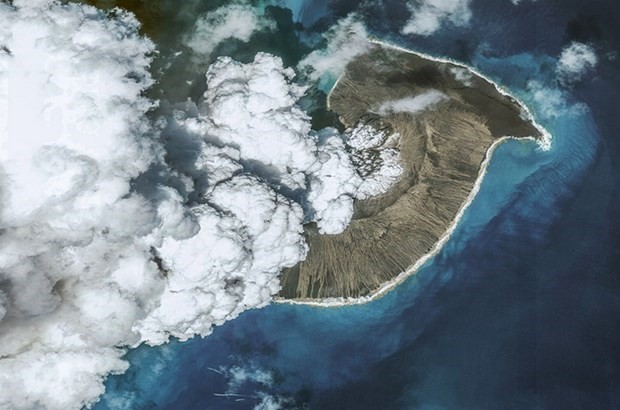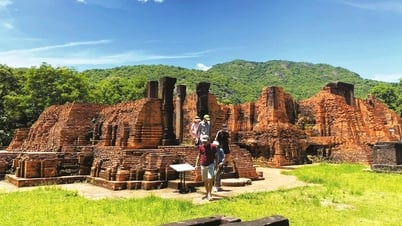 |
| The Hunga Tonga-Hunga Ha'apai volcano sent shockwaves across the globe and created a plume of steam that pumped billions of kilograms of water into the stratosphere. (Source: Getty Images) |
Scientists in New Zealand recorded that the 2022 Hunga Tonga-Hunga Ha'apai volcano eruption in the South Pacific island nation of Tonga rapidly destroyed the ozone layer.
In a study published in the journal Science on October 20, scientists said that the event that occurred on January 15, 2022, when the volcano erupted strongly, created a giant column of steam up to 55 km high, "erasing" 5% of the ozone layer in some areas in just one week. This marked the rapid destruction of the ozone layer.
This is the largest eruption since the volcanic eruption in Indonesia in 1883. Explaining further about this, scientist Olaf Morgenstern, who specializes in atmospheric and climate research at the National Institute of Water and Atmospheric Research of New Zealand, said that the above volcanic eruption is the largest eruption in the era when humans have achieved many achievements in conquering the universe and space.
This magnitude is based on the explosive force, the height of the ash plume, and especially the amount of water vapor that rises into the stratosphere.
To get this result, the researchers used balloons loaded with measuring instruments, which were released into the air to collect information about weather conditions and the ozone layer affected by the eruption. The measurements were deployed near the island of Reunion in the Indian Ocean and were conducted just five days after the eruption.
The dramatic increase in water vapor in the stratosphere caused a series of interactions between other components erupting from volcanoes, eventually destroying the ozone layer over the Indian Ocean and Southwest Pacific.
Theoretically, scientist Laura Revell of the University of Canterbury (New Zealand) explains that large-scale volcanic eruptions can create columns of ash, along with gases, solids and debris that are thrown into the stratosphere, about 15-50 km above the Earth's surface.
This is the region with the highest concentration of ozone - the "shield" that protects the Earth. Ozone depletion often occurs rapidly after each strong eruption due to the consequences of interactions involving Aerosol or Aerosol and chlorine gas.
However, Revell said a 5% ozone loss is significant. Meanwhile, the Antarctic ozone hole sees a steady decline of about 60% of the total ozone in the Earth's atmosphere from September to November each year.
Olaf Morgenstern said that some polar regions of the Earth, such as Antarctica, could see unusually low ozone levels after volcanic material reached these geographic regions. In addition, the 2022 eruption could affect tropical regions.
Source


![[Photo] General Secretary To Lam and international leaders attend the parade celebrating the 80th anniversary of the victory over fascism in Russia](https://vphoto.vietnam.vn/thumb/1200x675/vietnam/resource/IMAGE/2025/5/9/4ec77ed7629a45c79d6e8aa952f20dd3)

![[Photo] Russian military power on display at parade celebrating 80 years of victory over fascism](https://vphoto.vietnam.vn/thumb/1200x675/vietnam/resource/IMAGE/2025/5/9/ce054c3a71b74b1da3be310973aebcfd)

![[Photo] Prime Minister Pham Minh Chinh chairs a special Government meeting on the arrangement of administrative units at all levels.](https://vphoto.vietnam.vn/thumb/1200x675/vietnam/resource/IMAGE/2025/5/9/6a22e6a997424870abfb39817bb9bb6c)
![[Photo] Magical moment of double five-colored clouds on Ba Den mountain on the day of the Buddha's relic procession](https://vphoto.vietnam.vn/thumb/1200x675/vietnam/resource/IMAGE/2025/5/9/7a710556965c413397f9e38ac9708d2f)













![[Photo] Specialized school students show off their talents at the Dance Festival](https://vphoto.vietnam.vn/thumb/402x226/vietnam/resource/IMAGE/2025/5/9/5ee98081a3284b04a02b7f2a097cf121)












































































Comment (0)